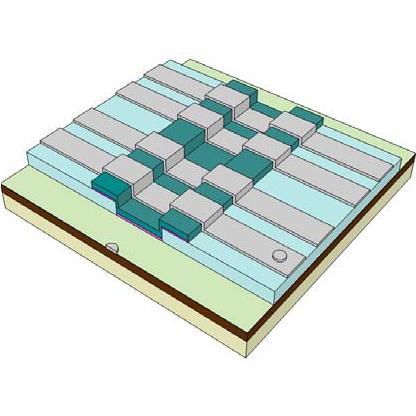Using an alternative to traditional microelectronics components, known as "spintronics" components, it will be possible to store more information in less volume, process information faster, and consume less energy

Using an alternative to traditional microelectronic components, known as "spintronics components", it will be possible to store more information in less volume, process information faster, and consume less energy.
Researchers from Ohio University demonstrated for the first time the use of electron spin to read and write information inside a plastic computer memory device.
Using an alternative to traditional microelectronic components, known as "spintronics components", it will be possible to store more information in less volume, process information faster, and consume less energy.
In the August issue of the scientific journal Nature Materials, researcher Arthur J. Epstein and his colleagues describe how they were able to make such a plastic spintronic prototype device using methods currently common in the computer industry.
Right now, the device is little more than a thin strip of blue organic magnet coated with a metallic ferromagnetic material attached to two lead electrodes. (A ferromagnetic material is a magnet made of an iron-like metal. Refrigerator magnets at home are such a type of magnet). And yet, the researchers were able to transfer information to it to retrieve it by controlling the spins of the electrons with the help of a magnetic field.
The researcher, a professor of physics and chemistry at Ohio University, describes the material as a hybrid between a semiconductor composed of organic materials and a semiconductor composed of a special magnetic polymer. As such, it forms a bridge between today's computers and the spintronics-based computers made entirely of polymers that researchers hope to develop in the future.
Normal electronic components encrypt computer information based on a binary code of zero and one, depending on the situation - whether an electron is present in a certain space of the material at that moment or not. However, researchers have known for a long time that electrons can be polarized so that they are arranged in specific directions, similar to a magnet. They define this orientation as spin - either "spin up" or "spin down" - and explore the ability to find a way to store information using spin. The electronic components based on this idea - known as spintronics components - will allow computers to efficiently store and transmit double the amount of information in each electron. However, higher data density is only part of the story.
"Spintronics is often seen as a way to get more information from each electron, but the truth is that it is a way to reach the next generation of electronics," explains the lead researcher. "We can solve many of the problems inherent in computers today by using spintronics."
Conventional printed circuits use a large amount of energy. Transferring electrons through them creates heat, and a large amount of energy is required to reduce this heat. Chip manufacturers are limited in how close they can pack the circuits together due to this cause of overheating.
Reversing the spin of the electron requires less energy, and produces almost no heat in the process, the researcher notes. This means that spintronics devices will be able to operate on smaller batteries. If they are made of plastic, then they will also be light-weight and flexible.
"We would very much like to transfer mobile electronic components to a spin frame," explains the lead researcher. "Think about soldiers on the battlefield who have to carry heavy battery packs. If we had a lighter-weight spintronic device that operates with lower energy requirements, and if we could make a flexible polymer monitor, soldiers and other users could simply roll it up and carry it with them. We see this mobile technology as a powerful basis for helping people."
The magnetic polymer semiconductor in this study, vanadium tetracyanoethaneide, is the first organic magnet capable of operating above room temperature, and was developed by the researcher Epstein and his colleagues.
"Our main achievement is that we used this material as a spin polarizer - that is, the information (spin up/spin down) found on a leaf can be saved while using a tiny magnetic field - and as a spin detector - that is, the information recorded on it can be read," explains the researcher. "Now, we are closer to developing a device composed entirely of organic materials."
In the prototype device, electrons hit the polymer, then a magnetic field directs them as spin up/spin down. In the next step, the electrons reach the normal magnetic layer, but only if the spins of the electrons are arranged in the same direction. If their direction is not appropriate, then there is too high a barrier for the passage of the electrons. So the researchers were able to read spin information from their device based on the presence or absence of a high barrier.

3 תגובות
LOL, commenter 2.
Only the whole thing won't turn out to be one big spin
"We would very much like to transfer mobile electronic components to a spin frame," explains the lead researcher. "Think about soldiers on the battlefield who have to carry heavy battery packs. If we had a lighter-weight spintronic device that operates with lower energy requirements, and if we could make a flexible polymer monitor, soldiers and other users could simply roll it up and carry it with them. We see this mobile technology as a powerful basis for helping people." The sequel is "killing other people..."